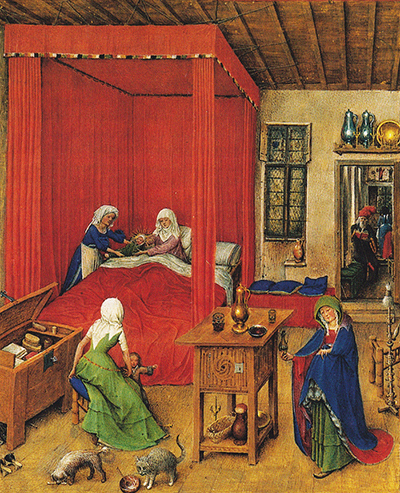This small artwork has been confirmed as having come from the hand of Jan van Eyck somewhere around the period of 1422 to 1425. The Birth of John the Baptist was produced on a piece of parchment measuring just 13cm long by 10cm wide.
Despite the small nature of the piece, van Eyck was still able to incorporate a large amount of detail. We find in front of us an indoor setting, with several maids helping out in the bedroom as this child is born. The content is derived directly from Luke 1 : 5-25, 57-79, in which the story of the Baptist's birth is described. You will also notice the colour scheme which focuses on the use of just a few tones, with blue, green and red playing a critical role in leading the eye towards key parts of the work. During the 14th and 16th century there was not the availability of oil paints in the way that there is today and so artists such as this would be forced into planning their work around which tones were available at the time. Use of a reduced palette would actually help bring a consistency across the painting.
Besides the maids helping out with the birth, there are also some other interesting details here, such as the central table with various drinking vessels - notice the slightly unusual use of perspective which underlines the connection to the styles of Gothic art which had influence van Eyck. There is also a large wooden chest to the left hand side of the room which also does not work in the style of perspective that we are now used to within art. In the foreground are some small animals, most likely the family's pets. The bed is adorned with bright red colouring which enables it to stand out, both in the bed covers but also with the hanging material which surrounds the new mother. To the right hand side are further points of interest such as the silverware that his carefully tidied away above the door, which itself leads through into another part of the house.
It is actually known to be Elizabeth who is the mother, whilst Zacharias is the individual sat in the other room, and at this time in European society the mother would not have their partners with them at the time of the birth, due to the conservative nature of life then. This painting can now be found in the collection of the Turin City Museum of Ancient Art, Turin, Italy and was created by van Eyck whilst in the employment of John III of Bavaria. An important note around this artist's career is that elements of this painting are known to have been repeated within one of his most famous paintings, namely the Arnolfini Portrait. One can compare the two to see these similarities and it was not unusual for this painter to cross elements from one work to another which helped to create a consistent set of visual language, similar to iconography.




